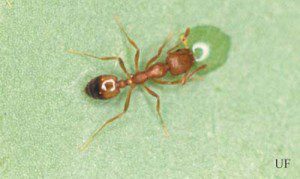Pharaoh Ant
By Chris Williams on March 14, 2016.
 The pharaoh ant is a species that I have not personally run across in many years, but which is still considered a major indoor pest in the United States. (http://entnemdept.ufl.edu/creatures/urban/ants/pharaoh_ant.htm)
The pharaoh ant is a species that I have not personally run across in many years, but which is still considered a major indoor pest in the United States. (http://entnemdept.ufl.edu/creatures/urban/ants/pharaoh_ant.htm)
Its generic name is Monomorium pharaonis (L). Its common name arose from the belief that perhaps this species was one of the seven plagues visited upon ancient Egypt recorded in the book of Exodus. It is still considered to be the most difficult to control of all the house infesting ants. Like many of our most infamous household pests (most cockroach species, Norway rat etc.) this ant has been distributed worldwide through commerce, and in the colder northern climates lives strictly indoors. It is thought to be native to the continent of Africa.
Pharaoh ant workers, unlike carpenter ant workers are all the same size and quite small at 1.5 to 2mm in length. They have two nodes at the junction of the abdomen and thorax (similar to the pavement ant) and are equipped with a stinger though it is rarely used. Color can vary from light reddish brown to red or even yellow. I’ve seen the yellow variant in some apartment buildings I’ve treated and even before I hit age 40 they were hard to see!!
One unusual aspect of the pharaoh ant’s biology and behavior that differs from other species is the lack of swarming (where winged male and female ants leave the nest) for mating. Mating takes place within the colony usually deep within a wall void and never seen. Colonies can vary in size from a few dozen to several thousand. They prefer it warm and humid. In my first experience with this species back in the late 80’s, I saw them trailing around the fixtures of a tub surround. I’ve seen them living in dishwasher doors, coffee makers, rice steamers, and other small appliances. Another aspect of pharaoh ant biology contributing to the difficulty in controlling them is that small autonomous colonies can split off from the main group. Oftentimes the reason for this may be avoidance behavior to some type of applied pesticide. Baiting for a while was the only good option for control, though with newer non repellant chemistries might be another useful tool in the arsenal. And like I said before, its been a while since I have seen these guys.
They’re still an important urban pest that have been known to infest bakeries, factories, office buildings and sensitive accounts such as hospitals. There have been reports of pharaoh ants contaminating IV bottles and wound dressings of burn patients. Pharaoh ants are known transmitters of several pathogenic organisms including Salmonella, and Staphylococcus and could contribute to hospital borne infections.